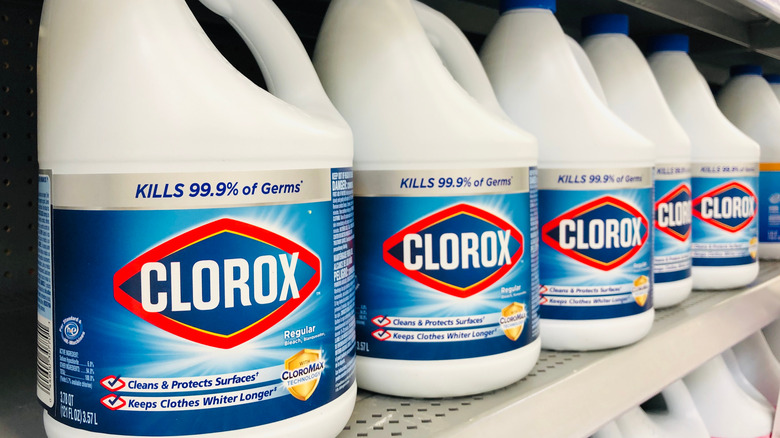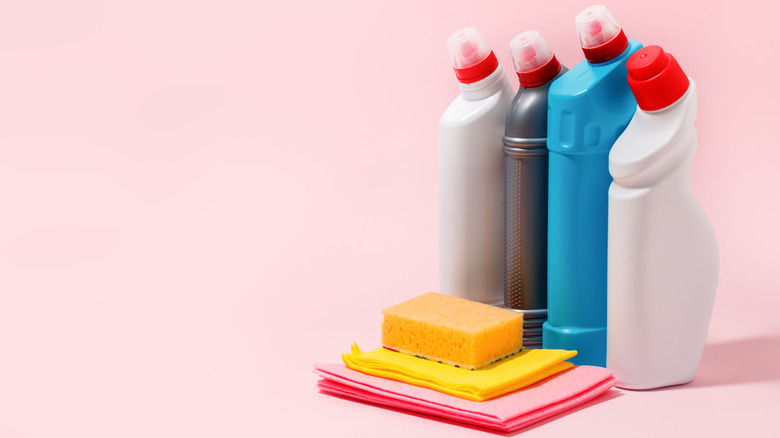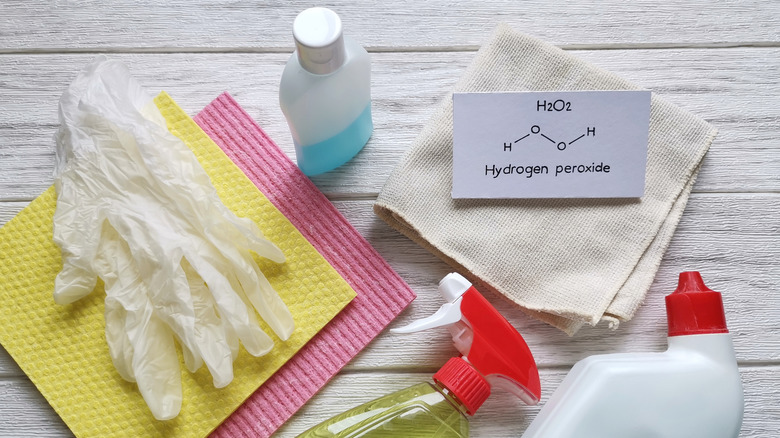Color-Safe Bleach Vs. Regular Bleach: What's The Difference?
Homeowners have used bleach in various capacities around the house for centuries, particularly to brighten white articles of clothing and to deep-clean germ-infested areas like bathrooms. Over time, bleach manufacturers have altered the product's traditional formula, creating lesser-toxic alternatives that are more gentle on the human body and the clothes you wash them with.
However, these products remain far from completely harmless. Bleach and its alternatives, when exposed to skin or eyes for too long, or in even more drastic situations, ingested, can cause irritation, chronic illness, and in extreme cases, death, per Beyond Toxics. While some sources, like Planet Ark, advise against using classic bleach around the home due to the product's physically- and environmentally-destructive properties, there are precautions you can take to safely use and store these chemicals, keeping your family safe while also keeping your clothes bright and stain-free. Here's what you need to know about regular and color-safe bleach, including how and when to use them.
Chemically different
The main quality differentiating color-safe bleach from traditional bleach is each product's chemical makeup. Regular bleach is often called "chlorine bleach" by consumers, though, according to Pearl Street Laundry, the active ingredient in the product is hypochlorite rather than tried-and-true chlorine. Scientifically, chlorine bleach chemically breaks down germs and bacteria found in dirt, mold, and other harmful substances found in your home, which, Co-op Market states, makes them easier to be washed away with water. Similarly, the chemicals inside traditional bleach wear down the fibers of the whites you wash it with, ultimately making them weaker each time you add it to your laundry.
Color-safe bleach, on the other hand, is usually referred to as "non-chlorine bleach" or "oxygen bleach" and primarily consists of hydrogen peroxide, a product commonly used to clean scrapes and cuts due to its ability to kill bacteria, says Live Science. Oxygen bleach is marketed as a product that thoroughly cleans your colored clothes without stripping them of their vibrant hues. Because the two products differ chemically, they should be added to loads of laundry at different times, as well. The American Cleaning Institute advises adding traditional bleach to a load of white laundry about five to 10 minutes after the wash cycle begins, after diluting the product appropriately. In contrast, add oxygen bleach to your washing machine before throwing in your colored load, the American Cleaning Institute states.
Is color-safe bleach safer?
In short, yes. Color-safe bleach is a weaker product when compared to traditional bleach because hydrogen peroxide is a weaker compound in comparison to sodium hypochlorite, per Co-op Market. However, this does not mean you should be any less careful when using and storing oxygen bleach around the house. Store your bleach, or bleach alternative, in a cool space of your home and out of the reach of children and pets. Science Notes states that chlorine bleach's shelf life is around three to five months. Storing bleach in a warmer place will require you to replace it faster. Oxygen bleach should be stored in similar conditions: a cool, dry place that prevents the product from spoiling. However, color-safe bleach has a shorter shelf life than its counterpart, per Science Notes.
Although the standard rule is to leave traditional bleach to white clothes, keep in mind the several clothing items that should never be washed with bleach. According to Clorox, never use bleach when washing anything consisting of spandex, wool, silk, mohair, or leather. In fact, Better Homes and Gardens recommends avoiding bleach even when these materials are used in small concentrations within clothes, like a 95% cotton shirt with a 5% spandex blend. Some items may even be too delicate for the washing machine entirely, requiring a hand wash inside a sink with gentle soap instead. Always check the label sewn inside your clothes to determine the best course of action to take when washing.


